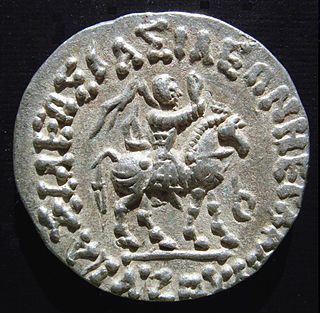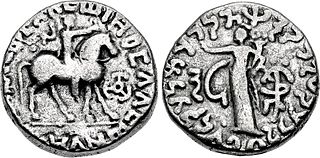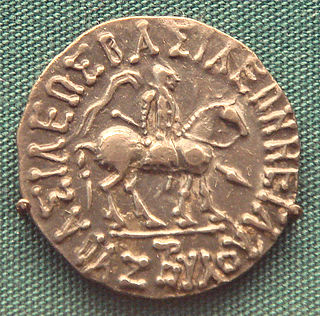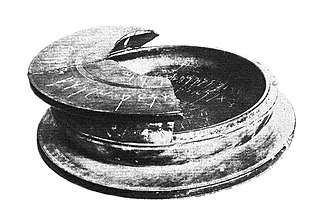
The Indo-Greek Kingdom, or Graeco-Indian Kingdom, also known historically as the Yavana Kingdom (Yavanarajya), was a Hellenistic-era Greek kingdom covering various parts of modern-day Afghanistan, Pakistan and northwestern India. This kingdom was in existence from c. 200 BC to c. 10 AD.

The Indo-Scythians were a group of nomadic people of Iranic Scythian origin who migrated from Central Asia southward into the northwestern Indian subcontinent: the present-day South Asian regions of Afghanistan, Pakistan and northern India. The migrations persisted from the middle of the second century BCE to the fourth century CE.

Azes II, may have been the last Indo-Scythian king, speculated to have reigned circa 35–12 BCE, in the northern Indian subcontinent. His existence has been questioned; if he did not exist, artefacts attributed to his reign, such as coins, are likely to be those of Azes I.

The Bimaran casket or Bimaran reliquary is a small gold reliquary for Buddhist relics that was removed from inside the stupa no.2 at Bimaran, near Jalalabad in eastern Afghanistan.

Kharahostes or Kharaosta was an Indo-Scythian ruler in the northern Indian subcontinent around 10 BCE – 10 CE. He is known from his coins, often in the name of Azes II, and possibly from an inscription on the Mathura lion capital, although another satrap Kharaostes has been discovered in Mathura.

The History of the Indo-Greek Kingdom covers a period from the 2nd century BCE to the beginning of the 1st century CE in northern and northwestern Indian subcontinent. There were over 30 Indo-Greek kings, often in competition on different territories. Many of them are only known through their coins.

The Apracharajas, also known as Avacarajas, were a local ruling dynasty of Gandhara. The Apracharaja capital, known as Apracapura, was located in Bajaur, though according to numismatic evidence and reliquary inscriptions, it is asserted that their territory encompassed the region of Gandhara, inclusive of the cities of Taxila and Pushkalavati. Under the administration of Sases, this domain expanded to incorporate the former territory of the kingdom of Porus, which extended as far as the Ravi River in modern day Punjab.

Aspavarma or Aspa was an Apracha general who ruled in Gandhara. He was the son of the Apracharaja and general Indravarma who ruled in 50 CE.

The "Azes era" starting 47/46 BCE, was named after the Indo-Scythian king, "King Azes the Great" or Azes I. As a number of inscriptions are dated in this era it is of great importance in dating the reigns of several kings and events in early Indian history.

The Indo-Greeks practiced numerous religions during the time they ruled in the northwestern Indian subcontinent from the 2nd century BCE to the beginning of the 1st century CE. In addition to the worship of the Classical pantheon of the Greek deities found on their coins, the Indo-Greeks were involved with local faiths, particularly with Buddhism, but also with Hinduism and Zoroastrianism.

The legacy of the Indo-Greeks starts with the formal end of the Indo-Greek Kingdom from the 1st century, as the Greek communities of central Asia and northwestern India lived under the control of the Kushan branch of the Yuezhi, Indo-Scythians and Indo-Parthian Kingdom. The Kushans founded the Kushan Empire, which was to prosper for several centuries. In the south, the Greeks were under the rule of the Scythian Western Kshatrapas.

Indo-Greek art is the art of the Indo-Greeks, who reigned from circa 200 BCE in areas of Bactria and the Indian subcontinent. Initially, between 200 and 145 BCE, they remained in control of Bactria while occupying areas of Indian subcontinent, until Bactria was lost to invading nomads. After 145 BCE, Indo-Greek kings ruled exclusively in parts of ancient India, especially in Gandhara, in what is now present-day the northwestern Pakistan. The Indo-Greeks had a rich Hellenistic heritage and artistic proficiency as seen with the remains of the city of Ai-Khanoum, which was founded as a Greco-Bactrian city. In modern-day Pakistan, several Indo-Greeks cities are known such as Sirkap near Taxila, Barikot, and Sagala where some Indo-Greek artistic remains have been found, such as stone palettes. Some Buddhist cultural objects related to the Indo-Greeks are known, such as the Shinkot casket. By far the most important Indo-Greek remains found are numerous coins of the Indo-Greek kings, considered as some of the most artistically brilliant of Antiquity. Most of the works of art of the Greco-Buddhist art of Gandhara are usually attributed to the direct successors of the Indo-Greeks in Ancient India in the 1st century CE, such as the nomadic Indo-Scythians, the Indo-Parthians and, in an already decadent state, the Kushans. Many Gandharan works of art cannot be dated exactly, leaving the exact chronology open to interpretation. With the realization that the Indo-Greeks ruled in India until at least 10-20 CE with the reign of Strato II in the Punjab, the possibility of a direct connection between the Indo-Greeks and Greco-Buddhist art has been reaffirmed recently.

The Silver Reliquary of Indravarman is an inscribed silver Buddhist reliquary dedicated by Apracaraja king Indravarman in the 1st century BCE, which has been found presumably in the Bajaur area of Gandhara. Believed to have been fabricated at Taxila, the silver reliquary consists of two parts—the base and the cover—both being fluted, and the cover being topped by a figure of long horned Ibex. It has been dated to around the eighth or ninth decades of the 1st century BCE and bears six inscriptions written in pointillē style, in Kharoshthi script and Gandhari/north-western Prakrit. In form, the silver vessel is wholly atypical of Buddhist reliquaries and is said to have been a wine goblet, similar to others found in Gandhara and Kapisa regions. The vessel was later reused by Apraca king Indravarman as a Reliquary to enshrine Buddhist relics in a stüpa raised by Indravarman. The inscriptions on the silver reliquary provide important new information not only about the history of the kings of Apraca dynasty themselves but also about their relationships with other rulers of the far north-western region of traditional India i.e. modern northern Pakistan and eastern Afghanistan around the beginning of Christian era.
The Yavanarajya inscription, also called the Maghera Well Stone Inscription, was discovered in the village of Maghera, 17 kilometers north of Mathura, India in 1988. The Sanskrit inscription, carved on a block of red sandstone, is dated to the 1st century BCE, and is currently located at the Mathura Museum in Mathura. The inscription notes the donation of a water well and tank to the community in 1st century BCE, built by a Brahmana.

The Yavana Era, or Yona was a computational era used in the Indian subcontinent from the 2nd century BCE for several centuries thereafter, probably starting in 174 BCE. It was initially thought that the era started around 180-170 BCE, and corresponded to accession to the Greco-Bactrian throne of Eucratides, who solidified Hellenic presence in the Northern regions of India. The Greeks in India flourished under the reign of the illustrious, Menander - greatest of the Yavana rulers, who campaigned as far as Pataliputra in Eastern India. It is now equated with the formerly theorized "Old Śaka era".

Indravarman or Indravarma, also called Itravasu on his coinage, was an Apracharaja who ruled in Gandhara, with his capital in Bajaur. He succeded the previous Apracharaja Indravasu, in 50 BCE and was the son of the Apracha general. Vispavarma. Indravarma had a son, Aspavarma, commander and later king, known from an inscription discovered at Taxila.
Indravasu was an Apracharaja ruling in Gandhara with his capital in Bajaur of modern Pakistan. He succeeded the previous Apracharaja, Vijayamitra in 32 CE.

Vispavarma was an Apracha general who ruled in Gandhara. He is described on multiple reliquary inscriptions bearing the title 'Stratega' or general, equivalent to that of Senapati and was the son of the Apracharaja, Indravasu.
The Rukhuna reliquary, also sometimes Rukhana reliquary, also described as the Bajaur reliquary inscription, is a Scythian reliquary which was dedicated and inscribed in 16 CE by Rukhuna, Queen of Indo-Scythian king Vijayamitra. The inscription on the reliquary, also called the Bajaur reliquary inscription, was published by Richard Salomon with a photograph in 2005, and gives a relationship between several eras of the period, and especially a confirmation of a Yavana era in relation to the Azes era, that is "Azes era= Yavana era - 128 years".

The Shinkot casket, also Bajaur reliquary of the reign of Menander, is a Buddhist reliquary from the Bajaur area in Gandhara, thought to mention the reign of the 2nd century BCE Indo-Greek king Menander I. The steatite casket is said to have contained a silver and a gold reliquary at the time of discovery, but they have been lost.


















